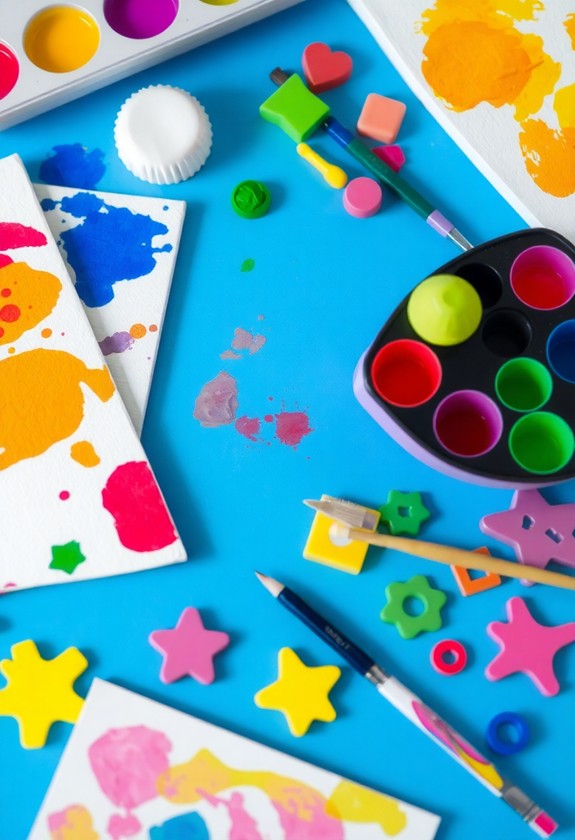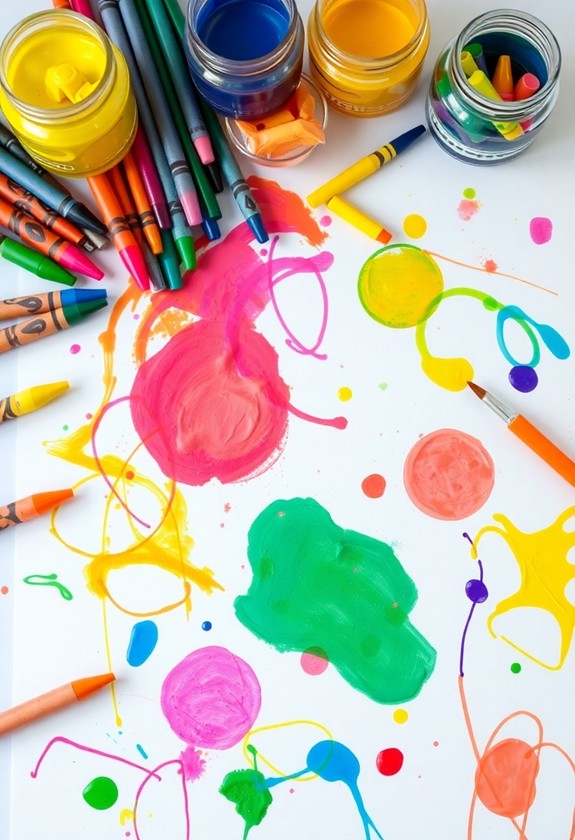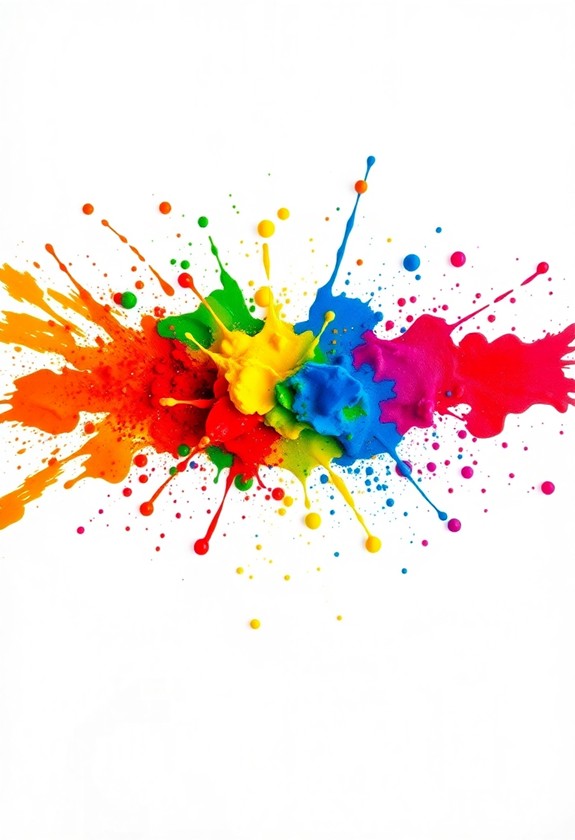Looking to boost your toddler's focus through art? Try these 7 exciting activities! Finger painting lets them get messy as they investigate colors. Play dough sculpting improves creativity and fine motor skills. Sticker collage making promotes expression and relaxation. Simple origami folding develops concentration and spatial reasoning. Watercolor resist art combines surprise elements with artistic investigation. Threading beads enhances hand-eye coordination and patience. Chalk drawing on sidewalks encourages outdoor creativity. These fun projects not only engage your little one's attention but also nurture their artistic abilities and cognitive skills. Each activity offers unique benefits, from sensory investigation to problem-solving. Ready to release your toddler's inner artist and watch their focus grow?
Creative Highlights
- Finger painting enhances focus through sensory exploration and encourages emotional expression through color manipulation.
- Play dough sculpting promotes concentration while improving fine motor skills and creative problem-solving.
- Sticker collage making boosts focus by requiring careful placement and pattern creation on a flat surface.
- Simple origami folding develops concentration through step-by-step instructions and precise hand movements.
- Threading beads improves focus by requiring sustained attention to slide beads onto string in specific patterns.
Finger Painting
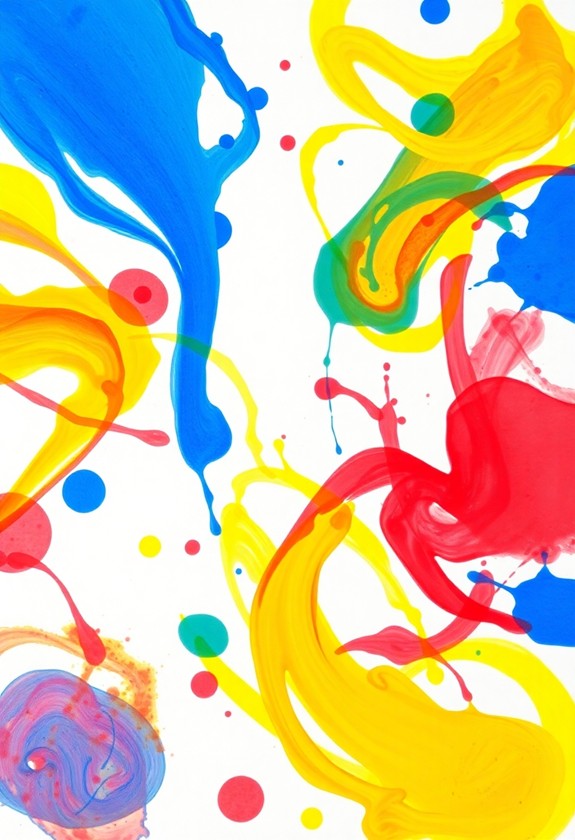
Finger painting is a messy but delightful art activity that toddlers adore. It's a fantastic way to boost their focus and creativity! Here's how to get started:
- Gather supplies: washable finger paints, large paper, and a plastic tablecloth
- Set up a painting station: cover the table and floor with the tablecloth
- Dress your little one in old clothes or a smock
Now, let the fun begin! Squirt small dollops of paint onto the paper and encourage your toddler to investigate. Watch as they swirl, smear, and create colorful masterpieces! This sensory investigation not only improves hand-eye coordination but additionally promotes emotional expression. But wait, there's more:
- Mix colors to make new shades
- Use different body parts (fingers, palms, even toes!)
- Add texture with sponges or brushes
Play Dough Sculpting
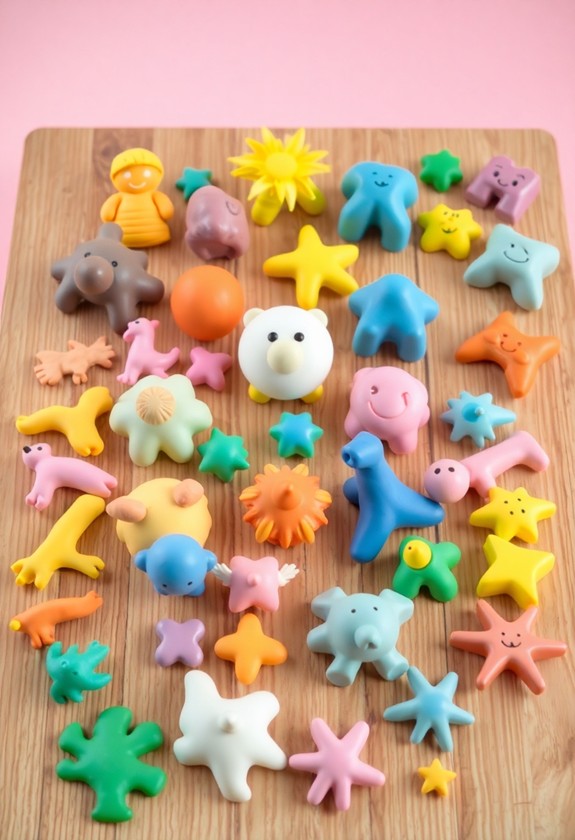
A classic among toddler activities, play dough sculpting offers endless opportunities for creativity and sensory exploration. It's time to get your hands messy and have some fun! Here's how to make the most of this moldable medium:
- Set up a dedicated space with easy-to-clean surfaces
- Provide a variety of play dough colors
- Offer tools like rolling pins, cookie cutters, and plastic knives
Let your little one squish, roll, and shape to their heart's content! Encourage them to create animals, foods, or silly creatures. Don't forget to join in the fun – it's a great bonding experience! Play dough sculpting, like sticky wall art, promotes fine motor skills and boosts creativity in a mess-controlled environment.
Pro tip: Make your own play dough at home for extra excitement! Mix flour, salt, water, and food coloring for a custom-colored creation. Your toddler will love helping you knead the dough!
Sticker Collage Making
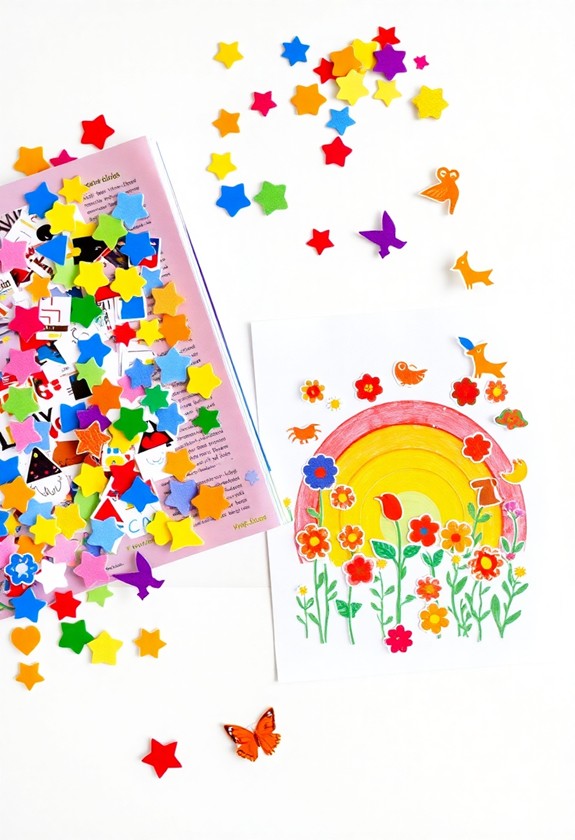
As play dough sculpting offers tactile fun, sticker collage making provides a different kind of hands-on creativity for toddlers. It's a fantastic way to boost their focus and fine motor skills! Here's how to get started:
- Gather supplies: colorful stickers, paper, and a flat surface.
- Let your little one go wild with sticker placement!
- Encourage them to create patterns or scenes.
Watch as your toddler's imagination sticks to the task! This activity isn't just a sticky situation – it's a chance for them to express themselves. They'll love peeling and sticking, and you'll love seeing their proud faces when they're done. Stress relief through creative outlets is an added benefit of this engaging activity, promoting relaxation and enjoyment for your little one.
Pro tip: Use themed stickers to teach concepts like animals, shapes, or letters. It's a stick-tacular way to learn! Remember, the goal is fun and focus, not perfection. So, let their creativity shine and watch their concentration grow!
Simple Origami Folding
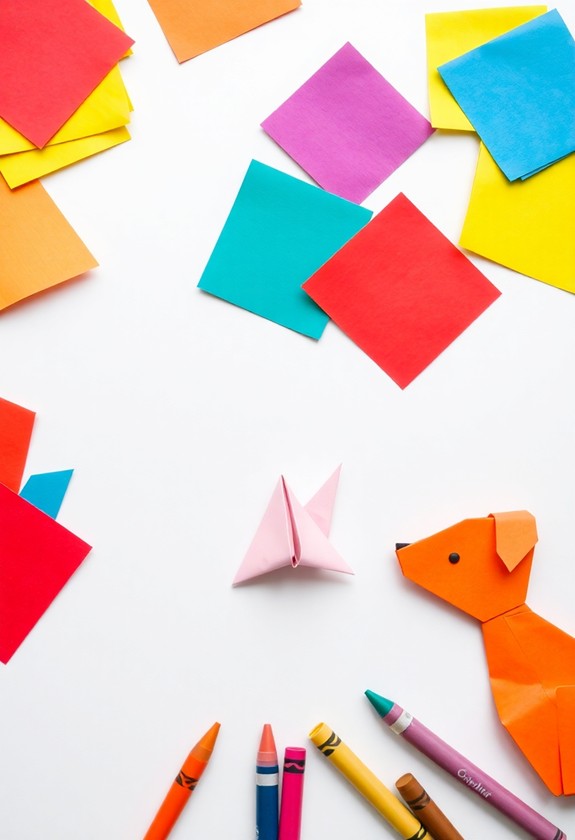
From sticky creations to folded wonders, let's explore the world of simple origami folding. This ancient Japanese art can be a blast for your little one! It's not just fun, it's fantastic for developing fine motor skills and concentration. Craft activities improve spatial reasoning and cognitive skills, making origami an excellent choice for toddlers aged 1-5. Ready to jump into it? Here's how to get started:
- Grab some colorful squares of paper
- Show your toddler how to fold in half
- Try making a simple boat or hat shape
Don't worry if it's not perfect – the joy is in the process! As your child gets better, you can try more complex shapes. How about a cute puppy face or a hopping frog? Remember, patience is key. Celebrate each fold, no matter how wonky! With practice, your little origami master will be creating paper masterpieces in no time. It's folding fantastic!
Watercolor Resist Art
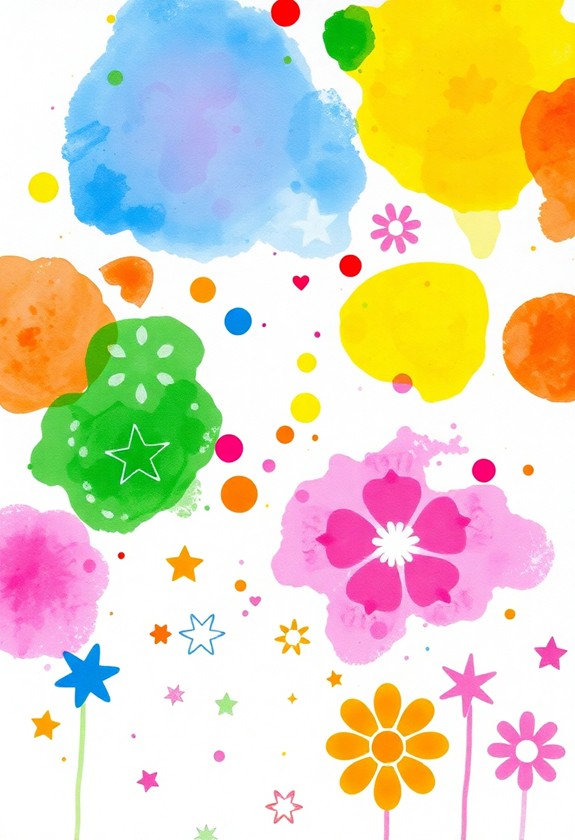
Watercolor-resist magic awaits your toddler in this next exciting art activity! Get ready for a colorful adventure that'll make your little one's eyes sparkle with wonder. Here's what you'll need:
- White paper
- White crayon or candle
- Watercolor paints
- Paintbrush
- Water
Start by having your toddler draw a secret picture with the white crayon. It's invisible now, but just wait! Next, let them splash watercolors all over the page. Watch their amazement as the hidden drawing appears like magic! The waxy crayon resists the paint, revealing their masterpiece. For added safety and convenience, consider using non-toxic and washable watercolor paints that are particularly designed for toddlers, ensuring easy cleanup and peace of mind.
This activity isn't just fun – it's a fantastic way to boost your child's creativity and fine motor skills. Plus, it's a sneaky science lesson about how different materials interact. Get ready for oohs, aahs, and giggles galore!
Threading Beads

Occasionally, toddlers need activities that improve their fine motor skills during keeping them engaged. Threading beads is a perfect solution! This fun, colorful activity will have your little one concentrating and creating in no time.
Here's how to get started:
- Gather large, colorful beads and sturdy string
- Tie a knot at one end of the string
- Show your toddler how to slide beads onto the string
Watch as your child's eyes light up with excitement! They'll love picking out their favorite colors and patterns. Plus, this activity helps develop hand-eye coordination and patience. It's a win-win!
Pro tip: Use pipe cleaners instead of string for easier threading. And don't forget to praise their efforts – every bead is a small victory! Soon, you'll have a budding jewelry designer on your hands. Bead-lieve it or not, it's that simple!
Chalk Drawing on Sidewalks

Let's step outside and explore another exciting art activity for toddlers! Chalk drawing on sidewalks is a fantastic way to release your little one's creativity as you enjoy the fresh air. It's so simple, yet so fun!
Here's what you'll need:
- Colorful sidewalk chalk
- A dry, flat surface (sidewalk or driveway)
Now, let the artistic adventure begin! Encourage your toddler to:
- Scribble freely
- Draw shapes and lines
- Create hopscotch patterns
- Trace their hands and feet
Don't forget to join in the fun! You can draw outlines for them to color or play games like tic-tac-toe. The best part? Clean-up is a breeze – just wait for the rain or grab a hose to wash it away. It's like a magical disappearing act! Your little Picasso will be chalking up tons of fun memories in no time!
Curious Little Questions
How Can I Encourage My Toddler to Participate in Art Activities?
Get ready for some artsy fun with your little one! Here's how to spark their creativity:
- Make it exciting! Set up a colorful art station with fun supplies.
- Let them choose! Offer different materials and see what catches their eye.
- Join in! Show them it's fun by creating alongside them.
- Praise their efforts! Be enthusiastic about their masterpieces.
- Keep it short and sweet! Toddlers have short attention spans, so aim for quick, engaging activities.
What Age-Appropriate Safety Precautions Should I Take During Art Sessions?
Safety first, fun second! In regards to toddler art time, you'll want to be on your toes. Here are some key precautions:
- Always supervise closely – little artists can be unpredictable!
- Use non-toxic, washable materials – no need for a "paint-ful" experience!
- Avoid small objects that could be choking hazards
- Secure art supplies when not in use – curious hands find everything!
- Have a clean-up station ready – messes happen, but they're part of the fun!
How Do I Manage Messy Art Projects in a Small Living Space?
Don't let a small space cramp your artistic style! Here's how to manage messy projects:
- Designate a "creation station" – use a folding table or clear a corner
- Protect surfaces with plastic tablecloths or newspapers
- Opt for washable, easy-clean art supplies
- Keep cleaning supplies handy for quick wipe-downs
- Use vertical space – hang a clothesline to dry artwork
- Store supplies in stackable bins or over-the-door organizers
Are There Alternatives for Toddlers Who Don't Enjoy Getting Messy?
Not all toddlers are fans of messy play, and that's okay! You've got options galore for clean, engaging art activities. Try:
- Sticker art – Peel and stick fun!
- Coloring books – Classic and clean!
- Magnetic drawing boards – Erase and repeat!
- Play-Doh (with a mat) – Squish and mold!
- Chalk on a chalkboard – Dust-free creativity!
These activities are just as exciting and beneficial for your little one's development. Remember, the goal is to have fun and investigate, not to create a mini-Picasso!
How Can I Incorporate Learning Objectives Into Toddler Art Activities?
You can make toddler art time a learning bonanza! Incorporate shapes, colors, and numbers into their creations. For example, ask them to draw three red circles or find all the blue objects. Play "I Spy" with different textures. Count brushstrokes or stickers together. Sing the alphabet during finger painting. Use nature walks to collect items for collages, teaching about the environment. Don't forget to label their masterpieces – it's a sneaky way to introduce letters and words!

